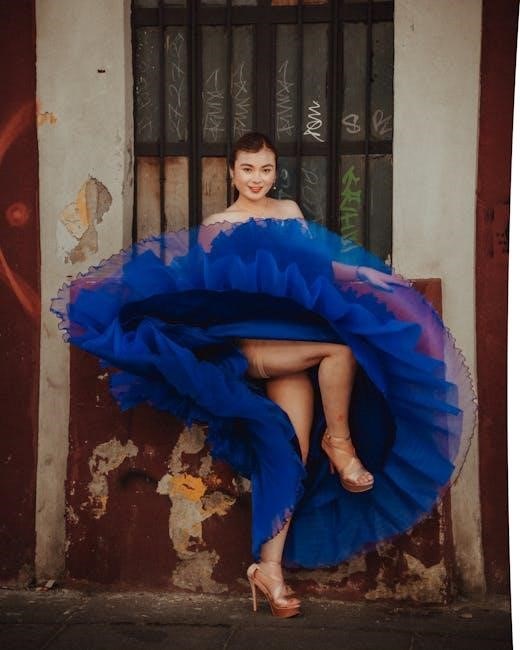A posing guide is essential for photographers and models, offering techniques to enhance confidence, natural expression, and visual appeal. It transforms ordinary shots into extraordinary, authentic moments.
Importance of Posing in Photography
Posing is a cornerstone of photography, enhancing confidence and creating authentic, visually appealing images. It helps subjects feel relaxed, allowing their true personalities to shine. By guiding models to adopt natural stances, photographers can capture genuine moments that tell stories. Techniques like using surroundings, body angles, and micro-expressions ensure balanced, engaging compositions. Avoiding stiff poses and forced smiles is key to professional results. Effective posing transforms ordinary shots into extraordinary ones, making it indispensable for photographers aiming to deliver impactful, memorable photographs.
Understanding the Basics of Natural Posing
Natural posing begins with relaxation and comfort, allowing subjects to express themselves authentically. Practical tips include keeping arms and legs slightly bent, avoiding stiffness, and distributing weight evenly. Subtle adjustments, like leaving space near the waist, enhance the overall look. Encouraging models to interact with their surroundings helps create genuine expressions. The photographer’s role is crucial in guiding these elements, ensuring a relaxed atmosphere for capturing candid, effortless poses that reflect the subject’s true personality and make the photo memorable and engaging.
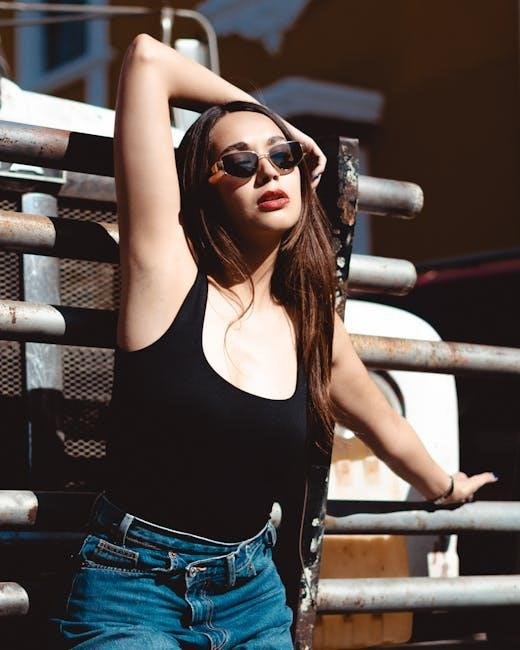
Relaxation and Comfort in Posing
Relaxation is key to natural poses. Photographers should create a calm atmosphere, use friendly conversations, and encourage models to interact with their surroundings for authentic, comfortable expressions.
How to Help Models Relax in Front of the Camera
Creating a comfortable environment is key to helping models relax. Start with simple poses and encourage interaction with surroundings to reduce tension. Engage in friendly conversation to build rapport and ease nerves. Subtle direction, like suggesting slight movements, helps them feel guided without pressure. Encourage natural expressions by focusing on authenticity rather than perfection. Use positive affirmations to boost confidence and reassure them throughout the session. Avoid stiff poses and forced expressions, opting for open, relaxed body language. Remind them to breathe deeply and naturally. A calm, supportive atmosphere fosters genuine, memorable shots, making the experience enjoyable for both model and photographer.
Techniques to Avoid Stiff and Unnatural Poses
To prevent stiffness, encourage models to keep their arms and legs slightly relaxed, avoiding straight lines. Soft bends in the elbows and knees create a more natural look. Subtle shifts in weight or gentle movements can add fluidity to poses. Avoid rigid hand placements by guiding models to rest hands naturally or use props. Encourage deep breathing to relax muscles and soften expressions. Direct models to focus on small, intentional movements rather than forced positions. This approach helps capture authentic, effortless poses that feel spontaneous and engaging, enhancing the overall photography experience for both the model and photographer.
The Role of Breathing in Relaxation
Breathing plays a crucial role in relaxation during posing. Deep, controlled breaths help calm the nervous system, reducing tension and stiffness. When models inhale deeply before a pose and exhale slowly, it promotes natural relaxation and softens facial expressions. This technique helps models feel more comfortable, leading to authentic and spontaneous poses. Encourage models to breathe naturally and avoid holding their breath, as this can create rigidity. Remind them to take a deep breath before each shot to release any pent-up tension, ensuring a more relaxed and genuine appearance in front of the camera.
Essential Posing Tips for Beginners
Mastering basic poses involves relaxation, natural expressions, and using surroundings to enhance shots. Keep arms and legs relaxed, avoid stiffness, and match poses to the model’s comfort and style.
Basic Standing Poses for All Body Types
Mastering standing poses is foundational for any photoshoot. For a natural look, keep weight slightly on one leg, bend the knee, and relax the arms. This creates balance and flow. Petite frames benefit from elongating poses, while taller subjects can angle away from the camera. Hourglass figures can highlight curves with a hand on the hip. Athletic builds can showcase strength with open, confident stances. Regardless of body type, soft expressions and subtle shifts in weight enhance authenticity and comfort in front of the lens.
Simple Sitting Poses to Look Natural
Sitting poses can create relaxed and authentic photos. Start with a slight lean forward, keeping shoulders soft and arms naturally placed. Hands can rest on thighs or knees for a casual vibe. Cross legs or ankles subtly to add dimension while avoiding stiffness. Use the environment—sit on a chair, bench, or floor—to enhance comfort. Shift weight slightly to one side for a natural posture. Avoid overly rigid or forced positions, as they can appear unnatural. Soft expressions and subtle angles complete the look, ensuring the pose feels effortless and genuine in front of the camera.
How to Use Hands in Poses Effectively
Hands play a crucial role in enhancing poses, adding expression and balance. Keep them relaxed and natural, avoiding stiffness or tension. Place hands gently on hips, thighs, or pockets for a casual look. Softly frame the face or tuck hair behind the ear for a subtle, elegant touch. Avoid over-extending or claw-like gestures. Use hands to interact with surroundings, such as leaning on a surface or holding props. Vary hand placements to avoid repetition and ensure the pose feels dynamic. Effective hand positioning complements the overall composition, creating a polished and authentic appearance in photos.
Advanced Posing Techniques
Mastering advanced techniques involves using body angles, lighting, and props to enhance poses. Practice and professional guidance help models and photographers achieve dynamic, transformative, and depth-filled images.
Using Body Angles for Flattering Results
Body angles are key to creating dynamic, flattering poses. Turning slightly away from the camera can slim the silhouette, while subtle shifts enhance curves. Angles add depth, making images more engaging and professional.
Micro-Expressions and Their Impact
Micro-expressions are subtle facial movements that convey emotion, adding authenticity to photos. They reveal genuine feelings, making images more engaging. A slight smile or raised eyebrow can tell a story, enhancing the shot’s depth. These fleeting expressions are more impactful than forced poses, capturing true personality. To achieve natural looks, encourage thinking of happy memories rather than forcing smiles. Intentional micro-expressions elevate photography, creating lasting impressions. Mastering them ensures captivating, relatable results, essential for professional and personal photography alike. They bridge the gap between pose and emotion, making moments unforgettable.
Posing with Props for Creative Shots
Props add depth and personality to photos, enabling creative storytelling. They can be objects like umbrellas, hats, or everyday items, helping models relax and express themselves naturally. Leaning against a wall or sitting on a staircase creates dynamic angles. Using props distracts from nervousness, fostering authenticity. Avoid overload; simple, meaningful items enhance shots without clutter. Props guide the eye, frame the subject, and add context, making images visually engaging and memorable. They are tools for creativity, turning ordinary scenes into extraordinary moments, and allowing personalities to shine through in unique, artistic ways.
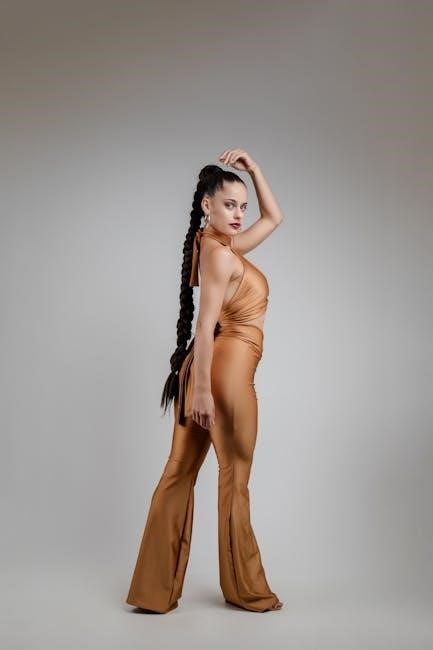
Posing for Different Body Types
Posing for different body types requires understanding each shape to highlight strengths and minimize flaws. Tailoring poses to flatter every figure boosts confidence and ensures natural expression.
Posing Tips for Petite Frames
For petite frames, focus on elongating the body and creating balance. Use high heels to add height and avoid bulky clothing that overwhelms the silhouette. Standing on tiptoes or angling the body can create a taller appearance. Placing one hand on the hip and extending the other arm slightly can slim the waist. When sitting, cross legs at the ankles to maintain elegance. Ensure the shoulders are relaxed and avoid slouching. Highlighting the upper body with open postures and using the environment to lean against can also enhance proportions. These techniques help create a balanced, confident look tailored for petite figures.
Flattering Poses for Hourglass Figures
Hourglass figures look stunning when poses emphasize their natural curves. Accentuate the waist by placing one hand on the hip and slightly angling the body. Standing with one leg slightly bent creates a balanced silhouette. Highlight the bust by pushing the shoulders back and keeping the chest lifted. Sitting with legs crossed at the knees or ankles can create a flattering S-curve. Use the environment, like leaning against a wall, to enhance the waistline. Avoid overly rigid poses and focus on soft, natural movements that celebrate the curves for a confident and elegant appearance.
Best Poses for Athletic Builds
Athletic builds shine when poses highlight strength and definition. Broad stances with feet shoulder-width apart emphasize a powerful lower body, while slightly raising the arms shows toned muscles. Keeping shoulders back and chest open accentuates a strong upper body. Dynamic poses, like a slight lunge or leaning forward, convey energy and movement. Avoid overly rigid poses; instead, opt for relaxed yet confident postures. Adding subtle tension to the muscles enhances definition without looking forced. Use props like dumbbells or bars for context, ensuring the focus remains on natural, athletic grace.
Posing Strategies for Pear-Shaped Bodies
For pear-shaped bodies, focus on balancing proportions by drawing attention to the upper body and slimming the lower half. Use angles to create a balanced silhouette, such as turning slightly sideways to the camera. Keep arms slightly away from the hips to avoid widening the lower body. When seated, cross legs at the ankles to create a slimmer line. Shift weight onto the back foot for a more balanced stance. Highlight the upper body with open poses or V-shapes, and use diagonal lines to elongate the frame. These strategies enhance confidence and create a flattering, proportional look in photos.
Facial Expressions and Eye Contact
Facial expressions and eye contact are crucial for conveying emotion. A soft gaze creates intimacy, while intentional looks add intensity, ensuring authentic and engaging photos.
Mastering the Soft Gaze
Matering the soft gaze involves relaxing your facial muscles to create a natural, inviting look. Practice gentle eye contact without intensity, ensuring it feels authentic. This technique enhances photographs by conveying calmness and approachability. It’s ideal for capturing candid moments and genuine emotions. Experiment with subtle expressions to avoid stiffness, allowing your eyes to reflect your personality; A soft gaze is particularly effective for portraits, as it draws the viewer’s attention and creates a sense of connection. Combine it with relaxed shoulders and a slight smile for a polished, professional appearance in any setting.
Creating Intentional Looks
Creating intentional looks involves directing facial expressions and eye contact to convey specific emotions or narratives. Practice narrowing your eyes slightly for dramatic intensity or softening them for a relaxed vibe. Direct eye contact can establish confidence, while avoiding it may suggest shyness or contemplation. Experiment with tilting your head or angling your face to add depth to your expression. These subtle adjustments help capture authentic moments and guide the viewer’s focus. Intentional looks are key to making photos engaging and emotionally resonant, allowing you to tell a story through your presence in the frame.
Chin Positioning for Confidence
Chin positioning is a foundational element in confident posing. Raising the chin slightly enhances confidence and reduces neck lines, creating a more defined jawline. Avoid tilting the head too high or too low, as this can cause discomfort or unflattering angles. Instead, keep the chin slightly forward and down to elongate the neck and project self-assurance. This subtle adjustment ensures a natural, poised appearance in photos, making it easier to capture authentic confidence and create impactful imagery. Proper chin placement is essential for conveying strength and ease in front of the camera.
Working with the Environment
Working with the environment enhances photography by utilizing surroundings to create natural, relaxed poses. Lean against objects, sit, or interact with the space to add depth and authenticity.
Using Surroundings to Enhance Poses
Using surroundings to enhance poses adds depth and context to your photos. Encourage models to interact with their environment by leaning against walls, sitting on stairs, or holding onto rails. Outdoor settings like parks or urban landscapes offer endless opportunities for creative poses. Natural elements such as trees, benches, or fences can serve as props to create authentic, relaxed shots. By incorporating the environment, you make poses feel more organic and visually appealing, ensuring the setting complements the subject rather than overpowering them.
Leaning and Sitting Poses Indoors
Indoor leaning and sitting poses offer versatility and comfort for models. Leaning against a wall or column can create a relaxed, confident look, while sitting on a chair, staircase, or couch adds variety. Encourage models to place their hands naturally on thighs or arms for a casual vibe. Soft angles and slight turns can enhance the pose, avoiding stiffness. Experiment with lighting to highlight features. These poses are ideal for capturing intimate, authentic moments indoors, ensuring comfort and natural expression for the model.
Outdoor Posing Ideas
Outdoor settings provide endless opportunities for creative posing. Use natural elements like trees, benches, or stairs to add interest. models can lean against a tree, sit on a bench, or walk along a path for dynamic shots. Encourage interaction with the environment, such as touching foliage or stepping on rocks. Soft gazes and intentional looks can enhance the connection with the surroundings. Props like fences or rails can also be incorporated for unique angles. Outdoor poses allow for natural movement and authenticity, creating memorable and engaging photographs. Experiment with light and shadows to elevate the visual appeal;
Posing for Confidence and Mindset
Confidence transforms a pose, making it magnetic. A positive mindset helps models embrace their uniqueness, fostering authenticity and self-assuredness in front of the camera, enhancing the final image.
Mindset Shifts for Better Posing
A positive mindset is crucial for effective posing. Embrace self-confidence, focusing on strengths rather than flaws. Practice relaxation techniques, like deep breathing, to reduce tension. Encourage models to visualize success, fostering a sense of empowerment. Guide them to adopt a growth mindset, viewing posing as a skill to master. Remind them that authenticity trumps perfection, allowing natural expressions to shine. Use positive affirmations to build confidence, helping them feel comfortable and assured in front of the camera. These mental shifts can transform their posture, facial expressions, and overall demeanor, leading to more compelling and genuine photos.
Building Confidence in Front of the Camera
Building confidence in front of the camera begins with relaxation and self-acceptance. Encourage models to embrace their uniqueness and focus on their strengths. Positive affirmations and constructive feedback can significantly boost their self-assurance. Guide them to practice deep breathing exercises to calm nerves and reduce tension. Remind them that imperfections are part of their authenticity, making photos more relatable. Help them visualize success and adopt a growth mindset, viewing each shoot as an opportunity to improve. By fostering a supportive environment, you empower them to express themselves naturally, resulting in authentic and compelling images.
Positive Affirmations for Models
Positive affirmations are powerful tools to boost a model’s confidence and mindset; Repeating phrases like “I am capable and beautiful” or “I embrace my uniqueness” helps reduce anxiety. Encourage models to focus on their strengths, fostering self-belief. Remind them that imperfections are natural and add character to photos. Affirmations like “I trust myself” or “I am worthy of being seen” create a positive atmosphere. These simple statements can shift their mindset, helping them feel empowered and authentic in front of the camera, leading to more natural and compelling images.
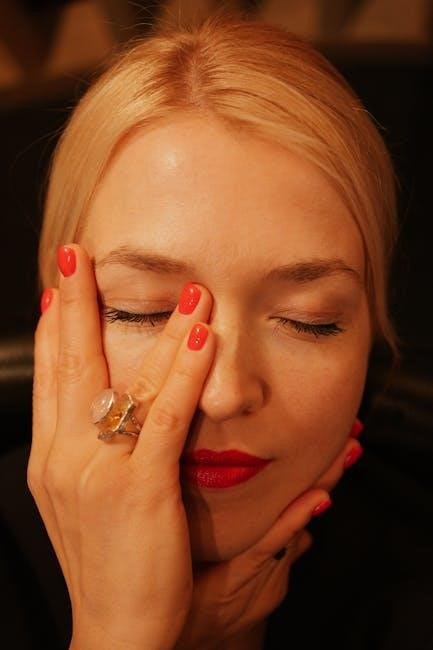
Posing for Group and Couple Photos
Posing for groups and couples requires balance and harmony. Encourage natural interactions, use surroundings creatively, and experiment with angles to capture authentic, dynamic shots together.
Group Posing Dynamics
Group posing dynamics focus on creating balance and harmony among subjects. Start with simple, relaxed stances, then gradually introduce interactions like leaning, touching, or subtle movements. Ensure each person has a defined role to avoid clutter. Experiment with varying heights and angles to add depth. Use props or environments to naturally guide the group’s formation. Soft gazes and intentional eye contact enhance authenticity. Avoid stiff, forced smiles by encouraging genuine exchanges. Direct the group to interact subtly, maintaining a cohesive yet dynamic composition that captures the essence of their connection and unity.
Couple Posing Ideas
Couple posing ideas emphasize natural interaction and emotional connection. Start with subtle touches, like holding hands or gentle leans, to create intimacy. Encourage walking or sitting together to capture relaxed, candid moments. Use the environment to frame their interaction, such as leaning against a wall or strolling through a scenic backdrop. Soft gazes and genuine smiles enhance authenticity. Experiment with slight movement, like swaying or turning, to add dynamism. Balance closeness with space to avoid overwhelming the frame. Props, like a hat or flowers, can add flair while keeping the focus on their connection. These poses celebrate love and togetherness naturally.
Creating Harmony in Group Shots
Creating harmony in group shots requires balance and cohesion. Start by arranging individuals at varying heights to avoid a flat look. Use the environment to frame the group, such as lining them up against a wall or arranging them around a central point. Ensure spacing is natural, with subtle gaps to prevent overcrowding. Guide them to relax with soft gazes and gentle smiles. Encourage natural interactions, like light touches or shared glances, to foster authenticity. Avoid stiff poses by suggesting slight movements, like shifting weight or leaning in. These strategies ensure group shots feel dynamic yet unified, capturing the essence of togetherness effortlessly.
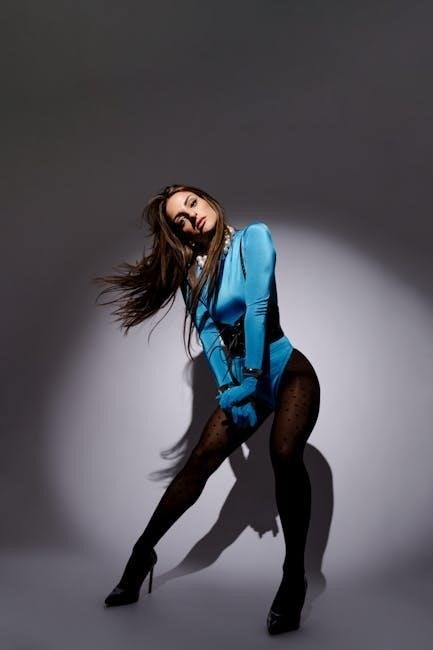
Avoiding Common Posing Mistakes
Steer clear of stiff poses, forced smiles, and awkward hand placements. Encourage natural expressions and relaxed body language to capture authentic moments and avoid unnatural results.
Common Mistakes to Avoid
One major mistake is forcing stiff poses, which can make subjects appear uncomfortable. Avoid rigid hand placements and overly dramatic expressions, as they often look unnatural. Forcing a smile can also detract from authenticity. Instead, encourage relaxation and subtle movements to create genuine moments. Directing models to mimic romantic partners can feel awkward and should be avoided. Additionally, failing to consider the model’s body type when choosing poses can lead to unflattering results. Always guide models with clear, constructive directions to enhance their confidence and comfort in front of the camera, ensuring more authentic and visually appealing shots.
How to Prevent Awkward Hand Placement
To avoid awkward hand placement, keep hands relaxed and slightly curved, avoiding stiffness. Avoid placing hands flat against the body or spreading fingers unnaturally. Instead, encourage natural gestures like resting hands in pockets, lightly grasping props, or gently placing them on thighs or shoulders. Guiding models to interact with their environment, such as leaning against surfaces or holding small objects, can also create more organic poses. Ensuring hands are soft and relaxed enhances the overall natural look, preventing rigidity and awkwardness in photos.
Fixing Forced or Unnatural Smiles
Forced smiles can appear stiff or unnatural, detracting from the photo’s authenticity. To fix this, encourage the model to relax their facial muscles and avoid over-directing. Instead of asking for a “big smile,” prompt them with relatable scenarios, like recalling a happy memory or imagining a joyful moment. Subtle cues, such as slightly raising the corners of the mouth or softening the eyes, can create a more genuine expression. Breathing exercises or light conversation can also help the model feel at ease, resulting in a natural, relaxed smile that enhances the photo’s appeal.
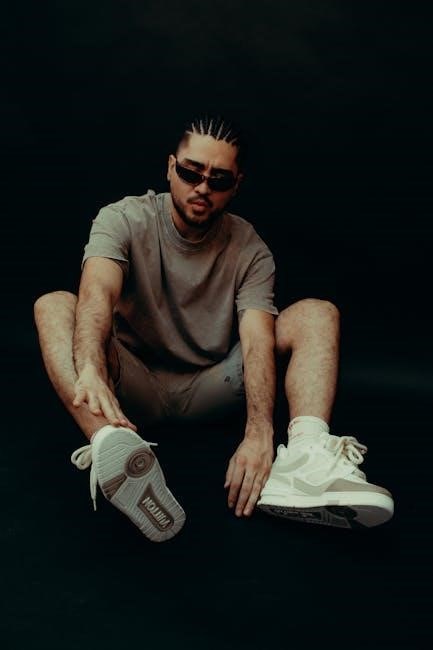
Practice and Improvement
Regular practice and feedback are key to mastering posing techniques; Study inspiring photos, create mood boards, and stay updated on trends to continuously refine your skills.
Practicing Posing Techniques
To master posing, start by creating a mood board of inspiring photos and experimenting with angles. Practice in front of a mirror to understand how your body looks in different poses. Begin with simple standing and sitting poses, then gradually explore more complex positions. Use props like chairs or walls to enhance your practice. Consistency is key—regular practice helps refine your skills and builds confidence. Over time, you’ll develop a natural, authentic style that translates effortlessly in front of the camera.
Learning from Feedback
Feedback is invaluable for refining your posing skills. After a photoshoot, ask your photographer or subjects for honest insights on what worked and what didn’t. Pay attention to how your body angles and expressions translate in images. Use mirrors to self-evaluate and make adjustments. Constructive criticism helps identify blind spots, like unnatural hand placement or stiff posture. Incorporate this feedback into your practice routine, focusing on improvements tailored to your body type and personal style. Over time, this iterative process will enhance your confidence and mastery of posing techniques, ensuring authentic and flattering results in every shoot.
Staying Updated with Trends
Staying updated with the latest posing trends ensures your photos remain fresh and relevant. Follow photography blogs, social media, and influencer content to discover new ideas. Study how celebrities and models pose in editorials and campaigns for inspiration. Experiment with modern techniques, such as relaxed, candid poses or dynamic angles, to add variety to your portfolio. Platforms like Instagram and Pinterest are great for visual inspiration. Regularly updating your approach keeps your work exciting and aligns it with current industry standards, helping you stand out in a competitive field while delivering modern, engaging results.
A posing guide transforms ordinary shots into extraordinary ones, emphasizing confidence, natural expression, and visual appeal. Continuous learning and practice refine skills, ensuring memorable, authentic moments captured with elegance.
Summarizing Key Posing Principles
Effective posing combines relaxation, natural expression, and intentional body placement; Key principles include softening gazes, avoiding stiff postures, and using surroundings to enhance shots. Breathing techniques promote comfort, while deliberate hand placement and chin positioning convey confidence. Matching poses to body types ensures flattering results. Practicing mindfulness and seeking feedback fosters growth. These principles, when applied thoughtfully, create authentic, engaging photographs that capture the essence of the moment, ensuring timeless and memorable imagery.
Encouragement for Continuous Learning
Continuous learning is key to mastering posing techniques. Experiment with new poses, seek feedback, and stay updated on trends. Practice regularly to build confidence and adapt to different scenarios. Embrace challenges as opportunities to grow and refine your skills. Keep an open mind to explore creative ideas and evolve your style. Learning is a lifelong journey, and dedication will help you excel in capturing authentic, flattering, and memorable moments. Stay inspired, stay curious, and keep improving your craft with every session.
